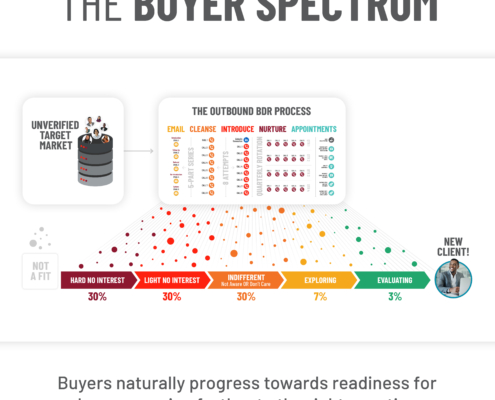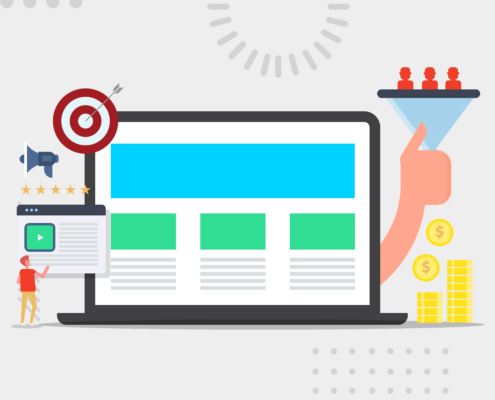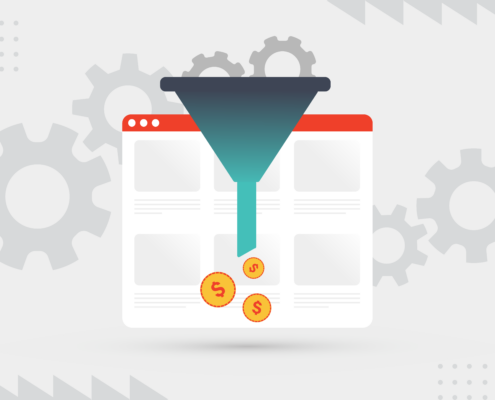

One of the biggest mistakes B2B businesses make with their lead generation efforts is that they don’t have a process in place that’s useful and sustainable for both sales and marketing teams. If you want to get the most impact from your growth efforts, sales and marketing alignment is essential. While it may sound like a time-consuming process, it’s not as intimidating as it may seem. And we’re here to give you some pointers on how you can achieve greater B2B sales and marketing alignment.
In this blog, we’ll cover the following:
- What is Sales and Marketing Alignment?
- What Problems Does B2B Sales and Marketing Alignment Solve?
- How Does Sales Support Marketing?
- How Does Marketing Support Sales?
- Who’s Responsible for B2B Lead Generation: Sales or Marketing?
- Best Practices for B2B Sales and Marketing Alignment
- How Does Outsourcing B2B Lead Generation Support Sales and Marketing?
What is Sales and Marketing Alignment?
Sales and marketing alignment is a critical strategy that successful businesses prioritize to enhance their revenue-generating efforts. It’s about ensuring that your sales and marketing teams work seamlessly together, sharing common goals, strategies, and insights. By focusing on sales and marketing alignment, B2B businesses can maximize their effectiveness in generating and converting leads, ultimately leading to increased revenue and sustainable growth.
The Role of Smarketing in B2B Lead Generation
Smarketing, the alignment of sales and marketing teams, plays a pivotal role in B2B lead generation. It ensures that both departments work collaboratively and efficiently to attract, nurture, and convert leads into customers.
The synergy between sales and marketing in B2B lead generation is essential. It maximizes the efficiency of lead generation efforts, increases the likelihood of converting leads into customers, and ultimately drives revenue growth.
What Problems Does B2B Sales and Marketing Alignment Solve?
B2B sales and marketing alignment solves several critical problems that businesses often face. A few of the most common issues companies face with their growth efforts include:
- Misalignment of goals
- Insufficient lead generation results
- Lack of communication between departments
- Issues with lead quality
- Challenges nurturing qualified prospects
- Poor sales enablement
- Inability to measure and optimize strategies
- Unsuccessful lead handoff process
Outsourced B2B lead generation empowers growing businesses to better align sales and marketing efforts, resulting in more closed revenue. Learn how our lead generation services can be your leading business development solution.
How Does Sales Support Marketing?
Sales plays a vital role in supporting marketing by providing customer insights, feedback on messaging, and lead quality validation.
Sales and marketing teams collaborate on content creation and share sales data to enhance targeted marketing campaigns. These sales enablement materials aid in customer conversations, while lead nurturing aligns with the buyer’s journey.
While sales takes charge of closing deals, marketing provides them with leads. And the better marketing does, the easier it is for sales to close. The only way for marketing to get better is to receive active feedback from sales on the sourced leads provided. Both teams work towards common revenue-driven goals and leverage customer testimonials to build trust.
How Does Marketing Support Sales?
Marketing plays a crucial role in supporting sales efforts by generating leads, providing targeted content, and facilitating the sales process. They attract leads through various channels, create content tailored to the buyer’s journey, and define lead qualification criteria.
It equips sales with collateral materials and automation tools while conducting customer research for better strategies. Marketing can help provide sales with hotter leads, by actively working with sales to identify successful and non-successful materials, campaigns, etc. Marketing helps enhance brand visibility and prioritize leads through scoring systems. Additionally, marketing offers training, analyzes campaign performance, and ensures a smooth lead handoff process.
Who’s Responsible for B2B Lead Generation: Sales or Marketing?
Both sales and marketing play pivotal roles in B2B lead generation.
Marketing is responsible for lead generation through various strategies and content creation, and they define lead qualification criteria. They also manage campaigns and analyze their performance.
Sales takes over once leads are qualified, engaging with prospects, building relationships, and ultimately closing deals.
However, successful lead generation requires strong collaboration and alignment between both teams. This ensures high-quality leads, efficient nurturing, and increased chances of conversion.
For more insight into each department’s involvement in lead generation, read our blog here.
Best Practices for B2B Sales and Marketing Alignment
Achieving effective B2B sales and marketing alignment is crucial for maximizing revenue and growth. Here are some best practices to facilitate alignment between these two departments:
Shared Goals and KPIs
Alignment of sales and marketing begins with establishing shared objectives and KPIs, emphasizing revenue growth, lead quality, and customer acquisition. This mutual understanding ensures that both teams work cohesively towards achieving these core business goals, fostering collaboration and synergy between them for better results.
For example, we use metrics like total leads, appointments, and pitches held as leading indicators for marketing to ensure that sales are on track. Understanding what the sales close rate goal is and how leads move through the pipeline can inform our marketing team of any strategy changes that are needed to obtain better results.
Consistent Communication and Feedback
To ensure effective sales and marketing alignment, foster open and regular communication between teams, utilizing scheduled meetings and collaboration platforms for exchanging insights and feedback. Implement a structured feedback loop where sales provides input on lead quality, nurturing, and marketing material effectiveness, allowing for continuous strategy and content refinement.
Additionally, schedule regular alignment meetings to review progress, address challenges, and plan future strategies, with a strong emphasis on data-driven discussions to drive continuous improvement. At Abstrakt, we try to have a weekly sales and sales enablement meeting to ensure that sales and marketing strategies are aligned and adjusted in real-time if needed.
Same Definition of What a Qualified Lead Looks Like
A collaborative approach to defining qualified leads involves both sales and marketing teams coming together to establish specific criteria. These criteria can encompass factors like demographic information, behavioral patterns, and engagement levels. This alignment ensures that marketing efforts are laser-focused on generating leads that are not only more likely to convert but also align closely with the ideal customer profile, optimizing the entire lead generation process.
Establish Service Level Agreements (SLAs)
Setting up Service Level Agreements (SLAs) is essential for streamlining lead management. These agreements clearly define the expectations and responsibilities of both sales and marketing teams. This includes aligning sales qualifiers like annual revenue, employee count, and more.
SLAs outline lead handoff procedures, response times, and post-handoff actions, ensuring a seamless transition and efficient collaboration between the two departments, ultimately improving lead management efficiency.
Collaborate on Content Strategy
Incorporating sales input into content creation sets your growth efforts up for success. Sales teams possess firsthand knowledge of customer pain points, objections, and common inquiries. Since sales is constantly speaking to prospects about their pain points, marketing teams can use that insight to create content that showcases how your company’s product or service provides relief. This valuable feedback enriches content development by ensuring that marketing materials directly address real-world challenges, resulting in content that resonates more effectively with the target audience.
Share Tools and Technology
The integration of technology solutions is vital for optimizing collaboration between sales and marketing. Seamless system integration guarantees that both teams share access to consistent data and analytics. This alignment fosters data-driven decision-making, enables real-time insights, and enhances overall efficiency in generating and converting leads.
Define a Lead Nurturing Workflow
Crafting lead nurturing workflows aligned with the buyer’s journey is essential. These workflows guide leads through various stages, providing them with relevant content and interactions. Marketing’s role is to nurture leads until they reach a sales-ready state, ensuring a seamless handoff to the sales team for conversion, which enhances the overall lead management process.
Practice Sales Enablement
Marketing’s support extends to equipping the sales team with essential tools and resources for effective lead engagement and conversion. This includes comprehensive product information, competitive analysis to highlight unique selling points, and objection-handling guides to assist sales professionals in addressing potential customer concerns, enhancing their ability to close deals successfully.
Use Data and Analytics to Measure Performance
Leveraging data and analytics is pivotal in evaluating lead generation effectiveness. By monitoring conversion rates, tracking lead behavior, and assessing campaign performance, businesses gain valuable insights. These data-driven insights enable informed decision-making, allowing continuous refinement and optimization of lead generation strategies for improved results and better targeting.
Continuously Optimize Your Sales Alignment Strategy
Sustaining alignment efforts is imperative due to the ever-changing sales and marketing landscape. Regular assessments and strategy adjustments are essential. By staying agile and adapting to market shifts and evolving customer behaviors, both teams can ensure their efforts remain effective, maintaining competitiveness and driving continuous growth.
Celebrate Each Other’s Wins
Celebrating collaborative successes is more than just acknowledgment—it’s a powerful motivator. Recognizing achievements achieved through sales and marketing alignment fosters a sense of unity, reinforcing the idea that both teams are stronger together. This motivation drives them to continue working harmoniously toward shared goals, further strengthening the alignment’s effectiveness.
How Does Outsourcing B2B Lead Generation Support Sales and Marketing?
Outsourcing B2B lead generation can provide valuable support to both sales and marketing teams when done strategically. Hiring a third-party sales and marketing company can help you fill gaps that could be missing that are preventing you from hitting your revenue growth goals.
Here’s a breakdown of how lead generation provides support for both marketing and sales teams.
Benefits for Marketing
By outsourcing lead generation, your in-house marketing team can concentrate on strategic planning, content creation, and brand building, rather than getting bogged down in lead generation tasks.
Outsourcing allows your marketing efforts to scale up or down quickly based on your business needs, without the need to hire and train additional staff, making it a more cost-effective solution. B2B lead generation agencies often specialize in this area and have a deep understanding of best practices, technologies, and strategies for identifying and nurturing leads.
And lastly, an external partner can bring fresh perspectives and innovative approaches to lead generation, helping your business stay competitive.
Benefits for Sales
A specialized lead generation agency can focus on finding and qualifying high-quality leads, ensuring that the sales team receives leads that are more likely to convert. This saves time for sales teams that would otherwise be spent on prospecting and lead qualification, allowing them to focus on closing deals and building customer relationships.
Lead generation agencies often provide valuable data and insights into lead behavior, helping sales teams tailor their approaches to individual prospects. This can help reduce your company’s average cost-per-lead; therefore, making your sales process more cost-efficient.
Outsourcing can provide a steady stream of leads, ensuring that the sales pipeline remains full and that sales professionals have a consistent flow of potential customers to engage with.
Lastly, outsourced lead generation often includes lead nurturing services, which can keep leads engaged and warm until they are ready to make a purchasing decision.
If getting a lead list isn’t enough for your efforts, checking out a B2B appointment setting service like Abstrakt’s Outbound BDR solution might be the missing piece of your growth puzzle.
Benefits for Both Sales and Marketing
Overall, lead generation outsourcing can facilitate better alignment between sales and marketing by providing a shared pool of leads and a common understanding of lead qualification criteria. They have the ability to scale lead generation efforts up or down can benefit both departments as business needs change.
While there are many lead generation companies to choose from, it’s crucial to choose the right outsourcing partner carefully. Consider their expertise, track record, and alignment with your business goals and values. Effective communication and collaboration between your internal teams and the outsourcing partner are also key to ensuring success in B2B lead generation outsourcing.
Key Takeaways
Sales and marketing alignment provides significant results in lead generation. Without effectively streamlining sales and marketing efforts, you risk high-quality sales leads falling through the cracks.
One of the biggest ways that sales and marketing teams can help each other is through implementing a sales development team that can serve as a liaison between the two departments. While marketing focuses on creating content and sales prioritizes closing deals, lead generation specialists can take the time to actively reach out to prospects and secure more sales meetings. At Abstrakt, we help sales and marketing teams maximize their growth efforts through outsourced B2B lead generation.
Our lead generation experts have all the tools, time, and expertise to help growing businesses fill their sales pipelines with qualified leads and nurture them until they’re ready to buy. When you’re ready to get the most from your business growth experts, contact our growth specialists!




